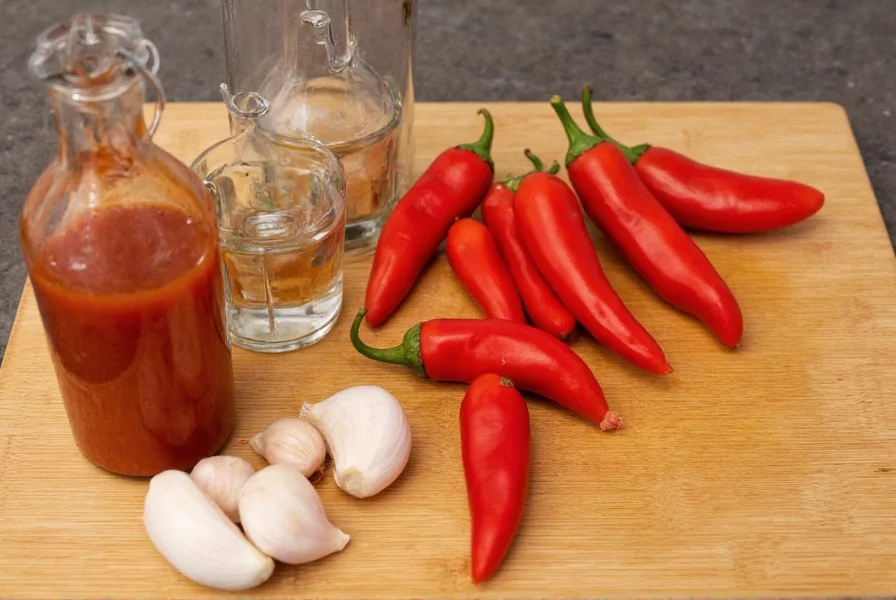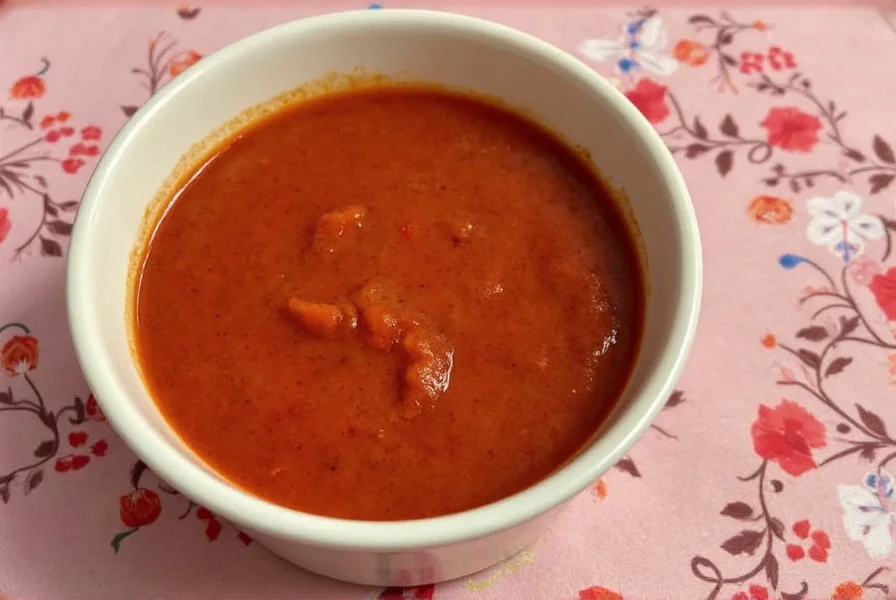Creating exceptional pepper sauce at home is simpler than most people realize. The key lies in understanding pepper varieties, proper acid balance, and safe preservation techniques. Whether you prefer mild bell pepper sauces for dipping or fiery habanero blends for serious heat lovers, mastering this versatile condiment opens up endless culinary possibilities.
The Essential Pepper Sauce Formula
Every great pepper sauce follows a fundamental ratio that ensures both safety and flavor balance. The magic happens when you combine fresh peppers with the right amount of acid and seasonings. Professional chefs and home cooks alike rely on this proven formula that prevents spoilage while maximizing taste.
| Pepper Type | Heat Level (Scoville) | Best Sauce Pairings |
|---|---|---|
| Habanero | 100,000-350,000 | Tropical fruits, citrus, Caribbean dishes |
| Jalapeño | 2,500-8,000 | Mexican cuisine, eggs, sandwiches |
| Serrano | 10,000-23,000 | Salsas, marinades, Bloody Marys |
| Bell Pepper | 0 | Dips, salad dressings, mild sauces |
Step-by-Step Pepper Sauce Recipe
Follow this foolproof method for restaurant-quality pepper sauce every time. This easy homemade pepper sauce recipe works with virtually any pepper variety and requires minimal equipment.

Ingredients
- 1 cup fresh peppers (stemmed and roughly chopped)
- 1/2 cup distilled white vinegar or apple cider vinegar
- 1/4 cup water
- 2 garlic cloves, peeled
- 1 teaspoon fine sea salt
- Optional: 1/2 teaspoon sugar or 1 tablespoon honey
Equipment
- Blender or food processor
- Small saucepan
- Fine mesh strainer (optional)
- Sterilized glass bottles with tight lids
- Funnel
Instructions
- Prepare peppers by removing stems and roughly chopping. Wear gloves when handling hot varieties like habaneros.
- Combine all ingredients in a blender and process until completely smooth.
- Pour mixture into a small saucepan and bring to a gentle simmer over medium heat.
- Simmer for 8-10 minutes to meld flavors and ensure proper acidification for preservation.
- Remove from heat and cool slightly before transferring to sterilized bottles.
- Seal tightly and refrigerate for at least 24 hours before using to allow flavors to develop.
Popular Pepper Sauce Variations
Once you've mastered the basic technique, experiment with these delicious variations that showcase how to make spicy pepper sauce from scratch with unique flavor profiles.
Tropical Habanero Sauce
Replace water with 1/4 cup fresh pineapple juice and add 1 tablespoon lime zest. This creates a bright, fruity habanero pepper sauce recipe without vinegar that balances intense heat with tropical sweetness. Perfect for seafood and grilled chicken.
Smoky Chipotle Sauce
Use 4-5 canned chipotle peppers in adobo sauce instead of fresh peppers. Add 1/2 teaspoon smoked paprika and 1 roasted red bell pepper. This variation delivers deep, complex flavors ideal for barbecue and Tex-Mex dishes.
Green Jalapeño Sauce
Use only green jalapeños (about 8-10 peppers) with tomatillos and fresh cilantro. This authentic Mexican-style sauce works beautifully as a table condiment or cooking base. For best results with this jalapeño pepper sauce recipe, use peppers at their peak freshness.
Troubleshooting Common Pepper Sauce Issues
Even experienced sauce makers encounter challenges. Understanding these solutions ensures consistent results every time you make pepper sauce from scratch.
Too Spicy?
Add sweetness with honey or fruit, or dilute with additional vinegar and water. Remember that heat intensifies slightly during the first week of storage as flavors meld.
Too Mild?
Incorporate hotter pepper varieties like cayenne or ghost peppers. Alternatively, let the sauce steep for 3-5 days before straining to extract more capsaicin from the pepper solids.
Separation Issues
Proper emulsification prevents separation. Blend longer (2-3 minutes) and consider adding 1/4 teaspoon xanthan gum while blending for a stable emulsion that maintains texture.
Storage Guidelines for Homemade Pepper Sauce
Understanding how long does homemade pepper sauce last is crucial for both safety and quality. Properly prepared and stored pepper sauce maintains freshness and flavor for extended periods.
Refrigerate your sauce in sterilized glass bottles with tight-fitting lids. Most vinegar-based sauces remain fresh for 3-4 weeks in the refrigerator. For longer storage, process filled bottles in a boiling water bath for 10 minutes to create a vacuum seal. Properly canned sauces can last 12-18 months in a cool, dark place.
Always check for signs of spoilage before using: mold growth, unpleasant odors, or significant color changes indicate the sauce should be discarded. When in doubt, throw it out.
Culinary Applications for Your Pepper Sauce
The versatility of homemade pepper sauce makes it invaluable in the kitchen. Beyond the obvious use as a table condiment, consider these creative applications:
- Whisk into mayonnaise for spicy sandwich spreads
- Add to Bloody Mary cocktails for homemade heat
- Stir into soups and stews for depth of flavor
- Use as a marinade base for proteins
- Mix with melted butter for flavorful dipping sauce
- Add to salad dressings for a spicy kick
Professional chefs often keep multiple pepper sauce varieties on hand because each brings unique characteristics to different dishes. The best peppers for hot sauce recipe depend on your intended use—milder sauces work well in dressings while hotter varieties shine as finishing touches.

Frequently Asked Questions
Can I make pepper sauce without vinegar?
Yes, you can create vinegar-free pepper sauce by using citrus juices like lemon, lime, or pineapple juice as your acid component. However, vinegar provides superior preservation qualities. Without vinegar, your sauce will have a much shorter shelf life (about 1-2 weeks refrigerated) and may require freezing for longer storage.
How do I adjust the heat level in my pepper sauce?
Control heat by adjusting pepper quantity and type. For milder sauce, remove seeds and membranes where most capsaicin resides. For hotter sauce, include these parts or add hotter pepper varieties. Remember that heat perception varies by individual and can intensify slightly during storage as flavors meld.
Why did my pepper sauce change color?
Color changes in pepper sauce typically occur due to oxidation or pH shifts. Green sauces may turn brownish when exposed to air, while red sauces can fade over time. To preserve vibrant color, use fresh peppers, minimize air exposure during storage, and ensure proper acid balance. Adding a small amount of ascorbic acid (vitamin C) can help maintain color stability.
Can I use dried peppers instead of fresh?
Absolutely. Rehydrate dried peppers by soaking in hot water for 20-30 minutes before blending. Dried peppers often provide more concentrated flavor, but you'll need to adjust quantities as their heat level can vary significantly from fresh peppers. This method works particularly well for creating complex sauces using multiple dried pepper varieties.
How can I make my pepper sauce thicker or thinner?
Adjust consistency by modifying liquid ingredients. For thicker sauce, reduce water content or simmer longer to evaporate moisture. For thinner sauce, increase vinegar or water proportionally. Some makers add a small amount of xanthan gum (1/8-1/4 teaspoon) to achieve restaurant-quality viscosity without altering flavor.











 浙公网安备
33010002000092号
浙公网安备
33010002000092号 浙B2-20120091-4
浙B2-20120091-4